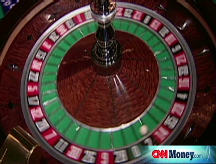Fed programs help ease credit
Government initiatives to reduce the stranglehold on lending help borrowing costs sink to all-time lows. Treasurys rise on continued economic concerns.
NEW YORK (CNNMoney.com) -- Lending rates continued to fall Friday, a sign that the government's numerous plans to ease the credit crisis are taking effect.
The overnight Libor rate fell for the fifth-straight day to 0.41% from 0.73% on Tuesday, according to the British Bankers' Association. It was overnight Libor's lowest level since the BBA began calculating the rate in 1997.
The 3-month Libor rate also dropped to 3.03% from 3.19% on Thursday.
Libor, the London Interbank Offered Rate, is a daily average of what 16 different banks charge other banks to lend money in the U.K.
Lending rates have been trending downward for the past several weeks. Just a month ago, 3-month Libor was over 4%, and the overnight rate was at an all-time high of 6.88%. Lower rates are a major boost for the strangled credit market, as more than $350 trillion in assets are tied to Libor.
"The credit crisis is tentatively solved - money is available to those who need it," said Pierre Ellis, senior economist at Decision Economics. "The next step is to get banks to trust each other, but that won't happen until we have a period of sustained stability."
The federal government has instituted several programs - costing trillions of dollars - aimed at easing funding concerns for banks and encouraging lending between financial institutions. These include measures such as lowering interest rates, injecting capital into banks and providing insurance on all non-interest bearing accounts.
One such program, the Fed's Commercial Paper Funding Facility, has provided critical short-term financing to businesses in desperate need of cash. The Fed said Thursday it has bought $143.9 billion in commercial paper since the program began Monday.
The Fed also reported Thursday that commercial banks borrowed a record $111.9 billion a day, on average, from its emergency lending window over the past week. Banks borrowing from the so-called discount window are able to borrow from the government for an interest rate of just 1.25%.
Many of these programs, including cutting $250 billion in checks to banks, have only recently come online, and analysts say it will still take time for the new initiatives to reduce the lending stranglehold that continues to grip banks.
"The federal government is stomping on the gas, and eventually the car is going to move," said Matt McCormick, portfolio manager at Bahl & Gaynor Investment Counsel. "We're beginning to see some cracks in Libor, but we're seeing a trickle, not a waterfall."
As rates fell, two key indicators of risk sentiment showed that confidence in the market was improving.
The Libor-OIS spread fell to 2.42 percentage points from 2.49 points Thursday. The spread measures how much cash is available for lending between banks, and is used for determining lending rates. The bigger the spread, the less cash is available for lending.
Another indicator, the "TED spread," fell to 2.69 percentage points from 2.82 points on Thursday. The TED spread measures the difference between the 3-month Libor and the 3-month Treasury bill, and is a key indicator of risk. The higher the spread, the less willing investors are to take risks.
"We're going into a recession, but lower rates are telling us that the world's not coming to an end just yet," McCormick said.
U.S. Treasurys rose Friday as investors anticipated a slew of economic indicators to be released later in the day would show even more weakness in an economy likely already mired in a recession.
A U.S. Commerce Department report released Friday said that personal spending declined at a faster than expected rate in September, falling to its lowest level in more than four years. Personal income grew more than expected, but September's increase was less than August's.
The benchmark 10-year note rose 29/32 to 101-5/32, and its yield fell to 3.86% from 3.97% late Thursday. Bond prices and yields move in opposite directions.
The 30-year bond gained 1-14/32 to 104-8/32, and its yield sank to 4.25%, from 4.33%.
The 2-year note was up 4/32 to 100, and its yield fell to 1.51% from 1.57% late Thursday.
The yield on the 3-month bill fell to 0.33% from 0.40% on Thursday as the price ticked higher.
The yield on the 3-month Treasury bill is closely watched as an immediate reading on investor confidence. Investors and money-market funds shuffle money into and out of the 3-month bill frequently, as they assess risk in the rest of the marketplace. A lower yield indicates that investors are less optimistic.
Treasurys were much lower Thursday as stocks gained around the world on news of the Fed's rate cut and an initial estimate of the country's gross domestic product showed the economy shrank less than expected. ![]()




